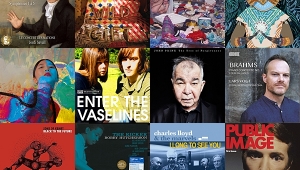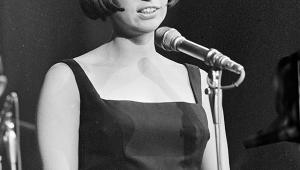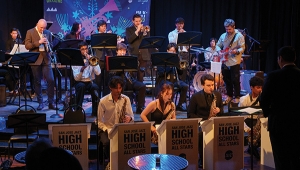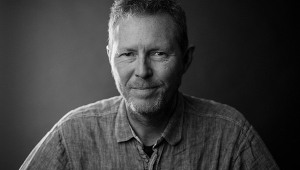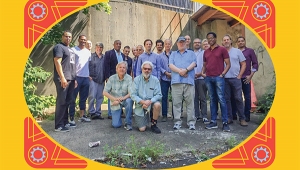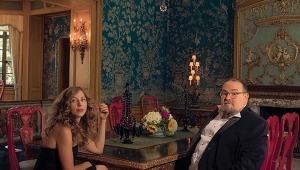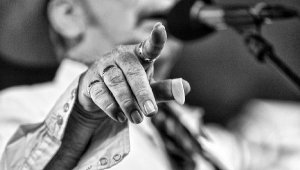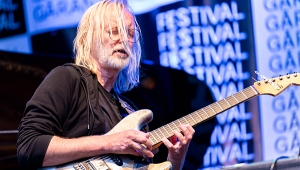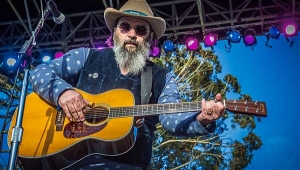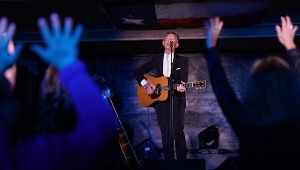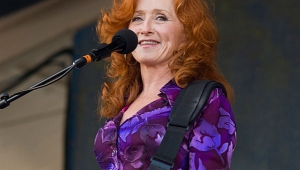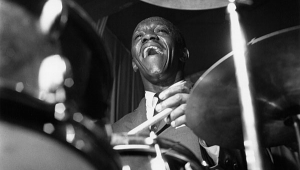| Columns Retired Columns & Blogs |
Attention Screen: The Making of Live at Merkin Hall
John Atkinson: Making It Live
The e-mail from Stereophile reviewer Bob Reina was straightforward: "I want to make a demo of my new jazz group. I plan to record the session in my living room by getting my old four-channel Teac 3440 out of mothballs and sticking one or two mikes on each instrument. I'd like your view on which mikes would be most appropriate for the four instruments . . . "
The e-mail from Stereophile reviewer Bob Reina was straightforward: "I want to make a demo of my new jazz group. I plan to record the session in my living room by getting my old four-channel Teac 3440 out of mothballs and sticking one or two mikes on each instrument. I'd like your view on which mikes would be most appropriate for the four instruments . . . "

After some thought, I got back to Bob with my ideas on miking and an offer to run tape for him. But what new group? Bob and I have been playing very occasional gigs in a jazz trio for the past eight years, and I have become well acquainted with the remarkable width and depth of his talent as a pianist. Bob is equally adept at Beethoven and Bill Evans, "Caravan" and "Oye Como Va," "White Room" and George Crumb. I also knew he'd recently been playing Hammond organ in a rock band. But a new jazz group?
Serendipity had been at work. Bob, an avid water-skier, had met a kindred spirit kindred spirit in Mark Flynn, who was introduced to Bob through their waterskiing trainer in Florida. Mark is a drummer whose childhood friend Chris Jones plays fretless Fender bass. Bob's neighbor Leela Fiorino had mentioned that her husband, Don, played guitar. It seemed natural for the four to get together. Which they did.
I got a phone call the day before the session—the Teac was misbehaving. "No problem," I responded. "I'll bring over my laptop and Metric Halo MIO2882 and record you in multitrack digital." Which I did, followed by a day of mixing and mastering. The resultant CD, La Tessitura, was released on a private label, and I must say I was surprised by how well it turned out. The music-making was inventive, the chemistry between the two old guys, Bob and Don, and the youngsters, Mark and Chris, was palpable, and the contrast between the acoustic piano and drums and the electric guitar and bass was vivid, with neither pair overpowering or embarrassing the other. In a subsequent bull session, Bob happened to mention that he'd performed an original work of his for cello and accordion at Carnegie Hall in 1987. (Accordion? Bob has no shame!) "Wouldn't it be cool if the new band played Carnegie and you recorded it?"
Why not?
The band decided to call themselves Attention Screen, and Bob contacted Carnegie about renting their Weill Recital Hall for an Attention Screen concert, to be recorded live for an eventual CD. The concert itself was financially doable, but the fees Carnegie would want to allow a recording were way too rich for our limited budget.

"How about Merkin Concert Hall at Kaufman Center?" I offered. "Wes Phillips and I were there for a Cantus concert last year. It seats more than double the number than Weill, has superior acoustics, you get the choice of two freshly tuned Steinways in the rental fee, and they're more amenable to recording. The piano won't be miked, so the other three players will have to set their levels accordingly, but I can then record the band as though it was a classical acoustic ensemble, with no equalization and no compression."
Bob was enthusiastic, and not just at the thought of being able to play in public on a world-class piano. "And you can give a talk in the interval on how you're recording us."
Thus it was, 10 months later, on Saturday, February 10, 2007, that I was frantically setting up mikes and running cables in Merkin in the two hours we had for setup before the audience took their seats. I'll let Wes Phillips discuss the evening's music-making before I describe how I recorded this most original of bands.—John Atkinson
Wes Phillips: Making It New
What do you call music by a group of composers dedicated to performing music that hasn't been composed?
Attention Screen guitarist Don Fiorino calls it "having a conversation. We start out here and we end up somewhere else; meanwhile . . . a language and dialog develops. Attention Screen's compositions are spontaneous, but they sound composed and arranged. Every song starts with a blank slate; the first notes shape the entire composition."
Pianist Robert J. Reina calls it "selective listening," because the band members listen to one another with intensity, then "selectively choose from among our repertoire of musical styles where to take it next. It requires a lot of concentration, but with players like Don, Chris, and Mark, I know it's going to sound good and I know I'm going to have fun."
Bassist Chris Jones likens it to a game. "While we're playing, I'm analyzing what we're doing harmonically and trying to come up with ways to shift the perspective of what you're hearing on the bottom end. It's like Rock, Paper, Scissors, in a way—whoever is 'winning' by presenting a strong harmonic argument, that's who I'll be following. I rarely initiate what's going on harmonically because it's probably easier for me to adjust to what's going on there than it is for everyone else to adjust to me."
Drummer Mark Flynn calls it "the most extreme act of music-ing—if that's even a word. It's composing at the same time you're playing, and we all bring to it everything we've experienced, separately and together. We have to listen to each other and support one another, but hopefully we'll also be expressing something personal as well. The key is active listening—otherwise, it can just be a mess."
Collective improvisation: The term is related to the concepts of soloist and accompanists. Where these functions are sharply differentiated the term is not normally used, even though all or most of the players may be improvising more or less freely. It is commonly applied in contexts where some or all members of a group participate in simultaneous improvisations of equal or comparable "weight," for example New Orleans jazz . . . and its related styles, and free jazz: it does not preclude the presence of a soloist but it implies a degree of equality among all of the members in the ensemble.—The New Grove Dictionary of Jazz, p.555
Wouldn't you know that even improvisation has rules?
"Even in improvisation," says Chris Jones, "you can follow a road map. You don't know what you're going to do, but you might know that it should be a chromatic or a melodic change, or a rhythmic adjustment. I suppose you might call it a 'modular vocabulary'—it's not as clear-cut as chance vs design, because you can incorporate a little of both. There are only a certain number of things that I can play in a given circumstance, but I also want to mix things up as much as possible. I like to inject as many timbres as musically possible. That offers different colors for people to wrap their heads around, because, let's face it, some of our music can be challenging to experience."
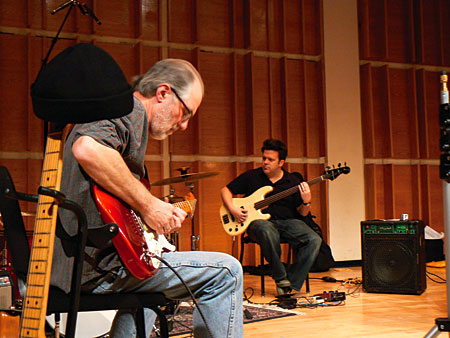
"What I'm looking for when we're playing together," says Mark Flynn, "is that point where we all awaken to the fact that we're here, and then we just try to ride that wave for a little while. I think that happens when we get a motif happening rhythmically—like when Chris gets a phrase rolling and I keep a rhythmic pattern going and keep the dynamics established. It may only happen a couple of times during a performance, but that right there is the payoff."
To Don Fiorino, it's "stepping out of one's self, listening and observing from the outside, using the Eastern philosophy of 'dissolving the ego'—for me, this is the core experience of improvising music. Working with other musicians, the intuitive takes over from the intellect. With the first passage of notes, the conscious decisions of where to go next fall by the wayside, and this other, intuitive, improvisational process kicks in. It's similar to an abstract-expressionist painter confronting the blank canvas, making the first mark, and then engaging in the creative process of making a painting."
- Log in or register to post comments
